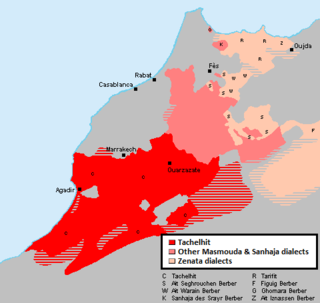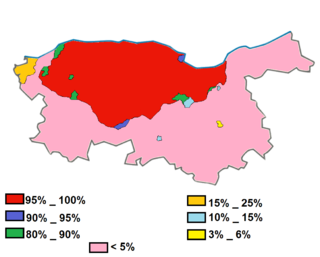Related Research Articles

The Tuareg languages constitute a group of closely related Berber languages and dialects. They are spoken by the Tuareg Berbers in large parts of Mali, Niger, Algeria, Libya, and Burkina Faso, with a few speakers, the Kinnin, in Chad.
Guttural speech sounds are those with a primary place of articulation near the back of the oral cavity, where it is difficult to distinguish a sound's place of articulation and its phonation. In popular usage it is an imprecise term for sounds produced relatively far back in the vocal tract, such as the German ch or the Arabic ayin, but not simple glottal sounds like h. The term 'guttural language' is used for languages that have such sounds.

Shilha, now more commonly known as Tashelhiyt, Tachelhit, is a Berber language spoken in southwestern Morocco. When referring to the language, anthropologists and historians prefer the name Shilha, which is in the Oxford English Dictionary (OED). Linguists writing in English prefer Tashelhit. In French sources the language is called tachelhit, chelha or chleuh.

Kabyle or Kabylian is a Berber language spoken by the Kabyle people in the north and northeast of Algeria. It is spoken primarily in Kabylia, east of the capital Algiers and in Algiers itself, but also by various groups near Blida, such as the Beni Salah and Beni Bou Yaqob.
The Zenati languages are a branch of the Northern Berber language family of North Africa. They were named after the medieval Zenata Berber tribal confederation. They were first proposed in the works of French linguist Edmond Destaing (1915) (1920–23). Zenata dialects are distributed across the central Berber world (Maghreb), from northeastern Morocco to just west of Algiers, and the northern Sahara, from southwestern Algeria around Bechar to Zuwara in Libya. The most widely spoken Zenati languages are Tmazight of the Rif in northern Morocco and Tashawit Berber in northeastern Algeria, each of which have over 3 million speakers.

Senhaja de Srair is a Northern Berber language. It is spoken by the Sanhaja Berbers inhabiting the central part of the Moroccan Rif. It is spoken in the Ketama area west of the Tarifit speaking area in eastern Rif.

Tarifit, also known as Riffian or locally as Tamazight is a Zenati Berber language spoken in the Rif region in northern Morocco. It is spoken natively by some 1,271,000 Rifians primarily in the Rif provinces of Nador, Al Hoceima and Driouch.

Central Atlas Tamazight or Atlasic is a Berber language of the Afroasiatic language family spoken by 3.1 million speakers.
Ghadamès also called Ghadamsi or Ghadamsian is a Berber language that is spoken in, and named after, the oasis town of Ghadames in Nalut District, western Libya.
Tetserret (Tin-Sert) is a Western Berber language spoken by the Ait-Awari and Kel Eghlal Tuareg tribes of the Akoubounou (Akabinu) commune in Niger. This main speech area is located between Abalak, Akoubounou and Shadwanka. The variant spoken by the Kel Eghlal is called taməsəɣlalt. The Tamasheq equivalent šin-sart / šin-sar / tin-sar is used in some older literature. Popular understanding among some Ait-Awari derives the name tet-serret, and its Tamasheq equivalent šin-sart, from expressions meaning 'the (language) of Sirte'.
Dr. Michael Peyron is a specialist in the field of Berber language, literature and culture. He is also well known as a writer on tourism in Morocco.
The Ait Seghrouchen are a Berber tribe of east-central Morocco. They are divided into two geographically separated groups, one on the south side of the Middle Atlas and one on the north side of the High Atlas. They speak a Zenati Berber dialect, Ait Seghrouchen Berber, sometimes grouped with Central Atlas Tamazight.
Proto-Berber or Proto-Libyan is the reconstructed proto-language from which the modern Berber languages descend. Proto-Berber was an Afroasiatic language, and thus its descendant Berber languages are cousins to the Egyptian language, Cushitic languages, Semitic languages, Chadic languages, and the Omotic languages.
Central Atlas Tamazight belongs to the Northern Berber branch of the Berber languages.

Tamazight of Djerba, Shilha of Djerba, Djerbi or Djerbian is a Berber language of the Eastern Maghreb, spoken on the island of Djerba, in Tunisia. It is a component of what is regularly denominated Tunisian "Shilha" or "Chelha" in the south of the country.
Beni Snous is a Berber variety close to Zenati languages spoken near Tlemcen in Algeria.

Berber orthography is the writing system(s) used to transcribe the Berber languages.

South Oran Berber, or Tachelhit, is a cluster of the Zenati languages, which belong to the Berber branch of the Afroasiatic family. It is spoken in a number of oases of southwestern Algeria and across the border in Morocco.

Gurara (Gourara) is a Zenati Berber language spoken in the Gourara (Tigurarin) region, an archipelago of oases surrounding the town of Timimoun in southwestern Algeria. Ethnologue gives it the generic name Taznatit ("Zenati"), along with Tuwat spoken to its south; however, Blench (2006) classifies Gurara as a dialect of Mzab–Wargla and Tuwat as a dialect of the Riff languages.

Eastern Middle Atlas Berber is a cluster of Berber dialects spoken in the eastern and north-eastern parts of the Middle Atlas, in Morocco. These dialects are those of the tribes of Ait Seghrouchen, Ait Warayn, Marmoucha, Ait Alaham, Ait Youb and Ait Mourghi.
References
- ↑ Abdel-Massih (1971b :xiii)
- ↑ Edmond Destaing, "Essai de classification des dialectes berbères du Maroc", Études et Documents Berbères, 19-20, 2001-2002 (1915)
- ↑ Augustin Bernard and Paul Moussard, Arabophones et berbérophones au Maroc, Annales de Géographie 1924, Volume 33 Numéro 183, pp. 267-282.
- ↑ Abdel-Massih (1971b :19–20)
- 1 2 Abdel-Massih (1971b :4, 6, 19–20)
- ↑ Abdel-Massih 1971b, p. 16.
- 1 2 Abdel-Massih (1971b:5)
- ↑ Abdel-Massih (1971b :11)
- ↑ Abdel-Massih (1971b :13–15, 20)
- ↑ Abdel-Massih (1971b :15)
- ↑ Abdel-Massih (1971b :15–17)
- ↑ Abdel-Massih (1971b :17–18)